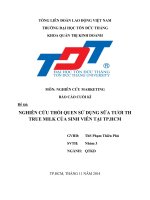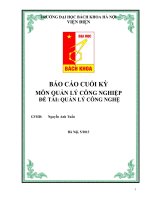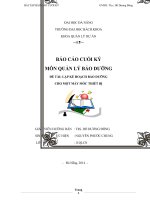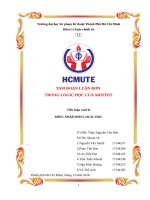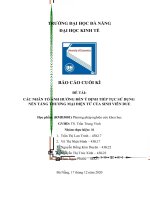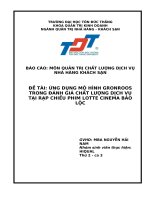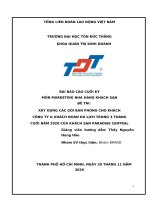báo cáo cuối kỳ q
Bạn đang xem bản rút gọn của tài liệu. Xem và tải ngay bản đầy đủ của tài liệu tại đây (4.39 MB, 20 trang )
<span class="text_page_counter">Trang 1</span><div class="page_container" data-page="1">
<b>GROUP MEMBER</b>
</div><span class="text_page_counter">Trang 2</span><div class="page_container" data-page="2">China's beverage market is undergoing a significant transformation, driven by risingdisposable incomes, changing lifestyles, and increasing urbanization. While tearemains deeply ingrained in Chinese culture, coffee consumption is witnessing aremarkable surge, with Chinese consumers embracing the beverage's unique tasteand cultural associations on an upward trajectory. The market is projected to havean annual growth rate of 15% from 2022 to 2026. This trend presents a lucrativeopportunity for Trung Nguyen Coffee, a leading company in coffee renowned for itsauthentic Vietnamese coffee flavors and robust heritage since 1996.
On November 23, 2017, Trung Nguyen Coffee established its representative officein Shanghai, China, and now, they are running 2 coffee shops there. Given China'srapidly expanding middle class and evolving consumption patterns, Trung Nguyenis poised to capitalize on the promising market landscape. This report delves intothe intricacies of the Chinese market, analyzing the political, economic, legal,cultural, social, technological, and ethical factors that will shape Trung Nguyen'sentry and success in this competitive arena.
</div><span class="text_page_counter">Trang 3</span><div class="page_container" data-page="3"><b>1. Political Environment1.1.Ideology of China</b>
China is a socialist country with only one party - the Chinese Communist Party(CCP). The General Secretary of the CCP holds supreme power and authority overthe state and government. Today, the authority of China's leaders is more closelytied to their grassroots.
<b>1.2.The political stability of China</b>
China's basic political system is a system of multi-party cooperation and politicalconsultation under the leadership of the Communist Party of China. China has astable political system, developed economic life, and increasingly high internationalstatus. China's political reforms aim towards a modernized socialist power that isrich, strong, democratic, civilized, harmonious, and beautiful.
Trung Nguyen is a famous Vietnamese coffee company, so when entering theChinese market, there may be certain possibilities and potential risks.
China has a large population and is the world's leading coffee-consuming market, sothis is a great opportunity for Trung Nguyen to expand its business scale andincrease revenue. In addition, Trung Nguyen also has experience exporting coffee tomany countries around the world, which helps the company understand and adapt toChina's export markets and regulations.
Besides, there are also potential risks such as strong competition from local andinternational coffee brands, so Trung Nguyen must always create a uniquecompetitive advantage. In any market, Trung Nguyen will face policy risks such asConflicts and protests. China's political situation is also related to internationalrelations. China has diverse relationships with other countries, including tradepartners, geopolitical partners, and geopolitical issues such as the South China Seaand Taiwan.
</div><span class="text_page_counter">Trang 4</span><div class="page_container" data-page="4"><b>1.3.China's Government Perspective on International Business</b>
China has participated in several bilateral and multilateral trade agreements, and theFTA between China and ASEAN countries has created the world's third-largest freetrade area. Furthermore, the Chinese Government has maintained low-interest ratesto attract investors. This policy helps Chinese goods become cheaper, increasingcompetitive advantage in the global market.
In addition, China has eliminated discrimination against imports into the domesticmarket, removed non-tariff barriers, and promulgated anti-dumping laws, fordomestic and foreign goods. Foreign countries are free to compete in the domesticmarket. Import management measures such as food hygiene and safety andenvironmental standards are applied. This makes investors feel secure and want toinvest in this market.
<b>1.4.Vietnam’s political relationship with China</b>
In recent years, relations between Vietnam and China have continuously developedstrongly, the two countries regularly exchange visits, trade and sign investmentcooperation agreements, creating conditions for Enterprises of the two countries todevelop business cooperation since January 1, 2010, when the ASEAN China Free
</div><span class="text_page_counter">Trang 5</span><div class="page_container" data-page="5">Trade Zone Agreement took effect. Both sides reduced import and export taxes,which is an opportunity for businesses to penetrate the market. Chinese marketTrade relations between Vietnam and China are increasingly expanding.Vietnamese businesses in general and Trung Nguyen Legend Group in particular inintroducing products and promoting trade brands as well as looking for Chinesepartners.
<b>2. Economic Environment</b>
China has a population of over 1.4 billion people, creating a vast consumer marketfor coffee products. This presents a significant opportunity for Trung NguyenCoffee Company to expand its business and seek new customers.
China's economy has witnessed remarkable development in recent decades and hasbeen regarded as one of the world's largest economies. China has a higher percapital income compared to Vietnam, approximately $11,891 per year (2021),whereas Vietnam's per capital income is $3,791 per year (2021). The increasingincome and improved living standards of the population have generated a growingdemand for premium coffee products and coffee experiences.
China's coffee market is becoming increasingly competitive with the presence ofvarious international and local coffee brands. This requires Trung Nguyen CoffeeCompany to compete by offering high-quality products and services to attractcustomers.
China plays a crucial role in Vietnam's list of trading partners. These two countrieshave signed a series of free trade agreements, including the China-ASEAN FreeTrade Agreement (ACFTA) and the China-Vietnam Free Trade Agreement(CVFTA), which have facilitated favorable conditions for the export and import ofgoods between the two nations. Therefore, Trung Nguyen can more easily enter theChinese market, benefiting from reduced tariffs and trade restrictions.
</div><span class="text_page_counter">Trang 6</span><div class="page_container" data-page="6"><b>3. Legal Environment</b>
China's Civil law covers real rights, contracts, personality rights, succession,... Itprioritizes the protection of personal, property, and lawful rights of individuals incivil legal relations.
<b>The Chinese Government's Perspective on Foreign Enterprises</b>
The Chinese government supports investment, fosters technology collaboration,promotes adherence to rules, and establishes strategic partnerships with foreignenterprises. It aims to create a favorable business environment, encourageknowledge transfer, and ensure compliance with laws.
</div><span class="text_page_counter">Trang 7</span><div class="page_container" data-page="7"><b>Intellectual Property Protection Policies in China</b>
The Chinese government has implemented policies to protect intellectual propertyrights through efficient registration systems, enhanced enforcement efforts, andinternational cooperation. For instance, China's Model Copyright Law was enactedin 1990 and has been revised in 2001, 2010, and 2020 respectively, and the latestrevision (2020) takes effect on January 1, 2021, these measures foster innovation,and attract foreign investment.
</div><span class="text_page_counter">Trang 8</span><div class="page_container" data-page="8"><b>Taxation System for Foreign Enterprises in China</b>
These taxes include Corporate income tax (CIT), value-added tax, import andexport taxes, industrial and commercial property ownership tax,... Compliance withtax obligations is essential for foreign enterprises to operate legally and successfullyin China's business landscape.
<b>The legal framework and trade relations between Vietnam and China</b>
The legal framework and trade relations between Vietnam and China encompassvarious aspects, including mutual recognition of laws, China's Commercial Law,Trade Agreement between Vietnam and China (1991), Payment Agreement onCooperation between the State Bank of Vietnam and the People's Bank of China(1993), Vietnamese Agreement South - China on Quality Assurance of Import-Export Goods and Mutual Recognition (1994). By understanding and adhering tothese legal frameworks, Trung Nguyen can easily develop its business in theChinese market.
<b>4. Cultural environment</b>
The Chinese buy luxury goods as a way to show the meaning of social advancementand self-differentiation. Wealthy Chinese consumers spend around $10,000 onluxury goods annually, with around 38% of the segment spending more than 15,000annually.
</div><span class="text_page_counter">Trang 9</span><div class="page_container" data-page="9">In 1993, China first established an Eco-labeling program for products. Thegovernment banned the use of thin plastic bags in all retail stores in June 2008,encouraging consumers to switch to reusable shopping bags.
Most Chinese people have the concept of "being prepared for danger in peacetime"and "spending yesterday's money and saving for tomorrow". PBoC data shows thatin 2022, new Chinese household savings deposited in banks increased to a recordhigh of 17.84 trillion yuan ($2.6 trillion) but the borrowings decreased by more than50%, under 5 trillion yuan ($564 billion).
</div><span class="text_page_counter">Trang 10</span><div class="page_container" data-page="10">Nowadays, the trend of having breakfast with coffee in China is increasing,especially the Gen Y generation (1980-1995), especially the trend of drinkingroasted and ground coffee. In 2021, generation Y contributes to 72.9% of totalroasted coffee consumption in the country of 1.4 billion people. In the first half of2022, the import volume of decaffeinated green coffee was 38,000 tons, with avalue of 150 million USD and 32,000 tons came from Vietnam (equivalent to 84%).In 2021, Vietnam also leads among the largest exporters of decaffeinated greencoffee to China, with an output of 32,358 tons. This is the best opportunity forTrung Nguyen Coffee to approach this market.
Chinese people, especially urban consumers, are increasingly interested in productsthat are healthy, high quality, and have clear origins. Trung Nguyen Coffee needs toorganize production according to VietGAP and GlobalGAP standards andstrengthen management and supervision of quality, food safety, and hygiene.
<b>5. Social environment </b>
China's National Statistics Agency announced on January 17 that the country'spopulation statistics had declined for the first time since 1961. China's population at
</div><span class="text_page_counter">Trang 11</span><div class="page_container" data-page="11">the end of 2022 is 1.41175 billion people, down 850,000 people compared to theend of 2021. According to Chinese Government forecasts, by 2035, the country willhave about 400 million people aged 60 and over, accounting for about 30% of thepopulation.
<b>Chinese population growth rate chart (%)</b>
Source: danso.org
</div><span class="text_page_counter">Trang 12</span><div class="page_container" data-page="12">China is facing the challenge of a long-term decline in the working-age populationand sharp increases in social security costs. But it's worth mentioning that nowChina's birth rate is falling without the one-child policy - when in many parts of theworld, the epidemic has pushed birth rates to deficient levels due to economicinstability and other factors of employment problems. Falling birth rates will affectthe labor market and economic productivity.
When low birth rates cause rapid population aging, it will increase social welfarefunds for the elderly and elderly care services. Some analysts predict that China isheading for disaster as the workforce shrinks further, pension funds dry up and thehealth system is overwhelmed.
</div><span class="text_page_counter">Trang 13</span><div class="page_container" data-page="13">Since October 2015, China has abolished the one-child policy, encouraging familiesto have 2 children, and by April 2021, allowing couples to have a third child.Besides, many measures have been taken such as increasing maternity leave,financial support for families, and organizing child care classes. Although thepopulation has decreased but not significantly, this is still the largest market in theworld, and what Trung Nguyen needs to do is to meet the demand and conquer thismarket.
<b>6. Technological Environment</b>
China has made significant progress in the field of technology, with leadingtechnology companies such as Alibaba, Tencent, and Huawei. The Chinesegovernment has implemented policies and regulations to promote development,including financial support and incentives for research and development in artificialintelligence, mobile communications, and especially e-commerce.
Global e-commerce revenue reached $5.5 trillion in 2022. According to statistics,China has the largest market share in e-commerce (50.2%), which is significantlyhigher than the second-ranked country, the United States, with only 19.2% marketshare. The remaining countries in the top 12 largest global market shares onlyachieved 1-4%.
</div><span class="text_page_counter">Trang 14</span><div class="page_container" data-page="14">In 2022, China's e-commerce sales reached 15.5 trillion Chinese yuan, with anexpected annual growth rate of about 12% from 2022 to 2025.
Thanks to resources such as technology, anti-monopoly regulations, and intellectualproperty rights, Chinese customers have increased their trust in online transactions.This has led to strong growth in e-commerce trading in China and represents apotential market for Rung Nguyen’s products.
</div><span class="text_page_counter">Trang 15</span><div class="page_container" data-page="15"><b>7. Ethics</b>
<b>7.1.Perspectives on child labor</b>
Accordingly, China's Labor Law prohibits employers from recruiting minors underthe age of 16. In addition, a series of specific action programs are also implementedby China such as: Education and development programs; The action plan againsthuman trafficking. China has been promoting preventive and intervention solutionsthat need to actively promote economic development, Culture and society inbackward and poor areas; raise awareness and understanding of legal policies ofchild employers.
Therefore, Trung Nguyen needs to ensure that it will properly implement the policyof the United Nations Convention on the Rights of the Child, as well as theInternational Labor Organization's Minimum Age Convention. In addition, strictsupervision of human resource management will be implemented to ensure thatworkers are recruited according to China's prescribed age, ensuring labor safety andworking time of workers according to China's regulations.
<b>7.2.Report on corruption in China:</b>
One of the biggest challenges to the long-term political and economic stability ofChina is corruption. It can be clearly seen that within 10 years, China’s corruptionCPI has improved quite well. China's expanding efforts in laws and regulations tocrack down on corruption in reports of the 2020 and 2021 CPIs shows China'scontinuous improvement from a CPI score of 39 in 2018 to 45 in 2021 and 2022.China continues to see active anti-corruption enforcement across differentindustries.
</div><span class="text_page_counter">Trang 16</span><div class="page_container" data-page="16"><b>7.3.China’s anti-corruption actions</b>
Central Commission for Discipline Inspection adopts the following four strategies:- Do not dare to be corruption
- Corruption is impossible - Not wanting to be corrupt- No need for corruption
In addition, select an entry structure that aligns with China’s laws and TrungNguyen's objectives. Secure all necessary licenses of chosen locations, sectors, andbusiness plans in the Chinese market. Periodically revisit Trung Nguyen'scompliance status in light of China’s always-evolving regulations. Moreover, theyshould expand the scope of operation only after first obtaining explicit approvalfrom the Chinese government. Understand China's import and export regulations,along with customs and tariff structures to transparently report the status of thebusiness.
It can be seen that China is the country that produces the most plastic waste,accounting for about 1/5 of the global plastic waste. According to China's NationalDevelopment and Reform Commission (NDRC) announced on January 19, 2020,by 2025, the production and use of many disposable plastic items will be graduallyeliminated. The new policy specifically stipulates when and in what areas each typeof plastic is banned. By the end of 2020, restaurants in major cities will be banned
</div>